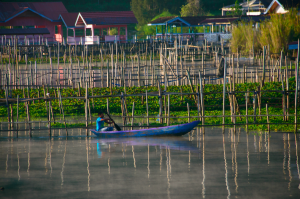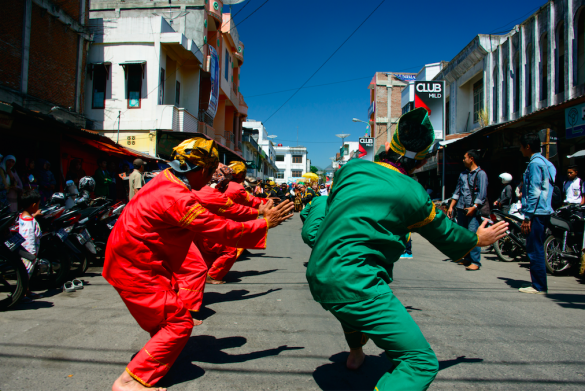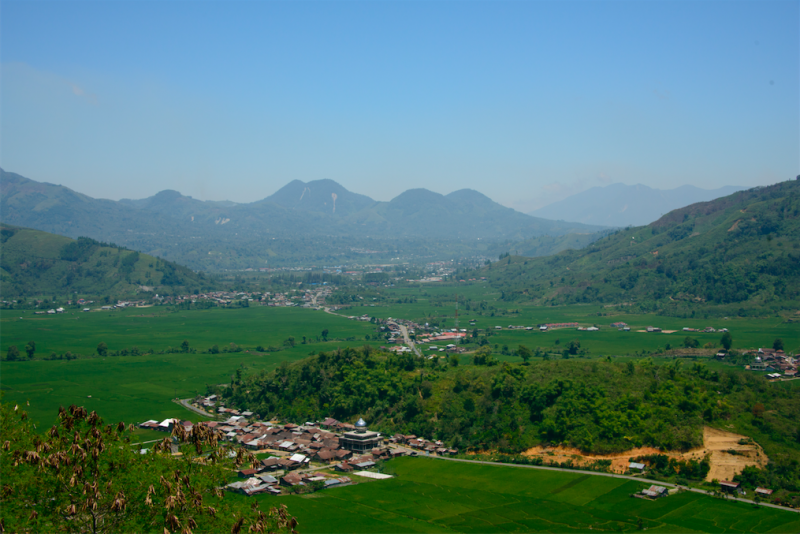Aceh is a beautiful place to explore and a trip to the Gayo highlands of Central Aceh will delight you with pine-studded mountainsides, remote village life and a beautiful little town called Takengon nestled beside a lake.
I made my way to Lake Tawar just outside of Takengon and met a delightful man, Pak Syamsudin, who told me about his ancestral home. “I am fifth generation and a descendant of Raja Beluntara, the original king of this district. This old house is over 150 years old,” he told me in a pensive tone. “The government did a deal with me a few years ago. They wanted my historic home and offered to move me to a nice, new modern house down the road for free if I would give them this original house, so I said why not?”
As I sat with him, I gazed up at the tall wooden beams, which were held together with five pegs and five posts. “The Dutch were here for a long time,” he said. “They built schools and gave us education. Take a look at this painting of Raja Beluntara. The painting was actually made from a photo found in a museum in Amsterdam.” Pak Syamsudin stood proudly next to the painting with his son and three grandchildren joining him for a photo opportunity.
Pak Syamsudin is the keeper of the old house. He receives government funding every three months for upkeep. He told me, “No one from the government ever comes to visit. The house sits empty but I’m fine with that.” His look was one of reflection as he stared up at the vertical panels; a design feature of a King’s home. “But I do miss living here,” he added.
He told me about the good relationship his village had with the Dutch. He went on to explain that in the early 19th century, the Dutch made an agreement to honour the kingdom. Part of the deal was to provide education for the local people, which even to this day they have maintained. Many Gayo people are poets and love to compete in verbal challenges, which are held regularly in the form of competitions in the villages and neighbouring towns.
I was lucky to witness one of these word-slinging poetry competitions late one night. It was a poetry recital and part of a celebration of a local boy’s circumcision ceremony. I was told the boy’s family were wealthy, so as part of the ceremony there was to be a didong; a poetry competition.
A word-game challenge that continues through the night, a didong involves two rival villages and only finishes when the sun comes up. They tell jokes and challenge each other mentally, and this is reinforced by loud applause when questions are answered correctly, and even louder cheers when the answer involves a clever response.
I arrived at 10pm and left at midnight. I was told the didong would go without a break until 2am. From 2am to 6am, the verbal challenge would move to a new level and involve dancing combined with teasing and taunting. Now and again, a village elder would have to come to the rescue with an answer if the contestant was unsure. Through this rescue technique, both audience and participants engage in a deeper understanding of their history and culture. The elders, who are the judges, declare the winner based on two factors: knowledge and wisdom.
The dance of a thousand hands
I was lucky enough to be invited to a Saman dance rehearsal one night in a tiny back lane in Blangkejren Village. I met Ali Muddin, a Saman dance teacher whose dance troop had toured the world and attended festivals in Kuala Lumpur, Melbourne, Berlin, Sydney and Thailand.
I was directed to sit on a beautiful hand-woven green and white Gayo mat, as a line of thirteen very keen teenage boys shuffled into the tiny two-room house. The Saman dancers sat in a long row, excited to practice their age-old dance in front of a foreign guest. It was just a normal Monday night practice, but the room was packed family members. The boys practice three times a week and must synchronize their movements at a very fast pace, not missing a beat.
The dance was absolutely mesmerizing from beginning to end. It involves slapping the body and shuffling the head from side to side, as the dance gathered momentum. Matching the pace of the music, the dancers moved their bodies in quick succession, co-ordinating hands, arms, necks and upper bodies in time to the music while singing. The dance reached a dramatic ending, where everyone burst into applause.
The origins of this dance come from the Gayo ethnic group. It is only performed in this part of Aceh. Ali told me that once a father has taught his son the dance, he no longer performs. “They all want to learn to dance,” Ali said, “because the Saman dance is one of the most popular dances in Indonesia. Many of the boys are lured by the opportunity to travel to Jakarta and other places, and maybe like me, go overseas.” Ali continued, “Every year a big dance competition is held in Jakarta. We keep winning the competition, and now they have banned us from competing. Can you believe it?”
Many grand festival events are held in the Gayo region. You can check with the tourism department and time your visit to coincide with one of these. On occasion, up to 5,000 dancers can perform the Saman dance.
I went to Aceh with a desire to travel from Banda Aceh in the North to Gunung Leuser National Park in the South. I spent one week traversing the countryside, much of it cloaked in coffee plantations, wide river systems, stunning scenery and touching encounters with the local culture.
From sitting in an old king’s house to discovering the Saman dance tradition in the small village of Blangkejren, Aceh was a trip of discovery, every day revealing a new wonder. Travelling to lesser-known places in Indonesia with just a rough plan and an open mind will always bring a trail of surprises and delight.
Fast Facts: Aceh Gayo
Province: Aceh
Area: 58,376 km²
Population: 4.732 million (2014)
How to get there: Banda Aceh to Takengon, the central highland area of Aceh, is 314km. It’s a slow and bumpy
ride. The roads are in average to poor condition and the journey takes 6.5 hours.
Tour guide and driver: Miss Ferzya www.getaceh.com
Accommodation: Linda’s Homestay – lindahomestay@yahoo.com




